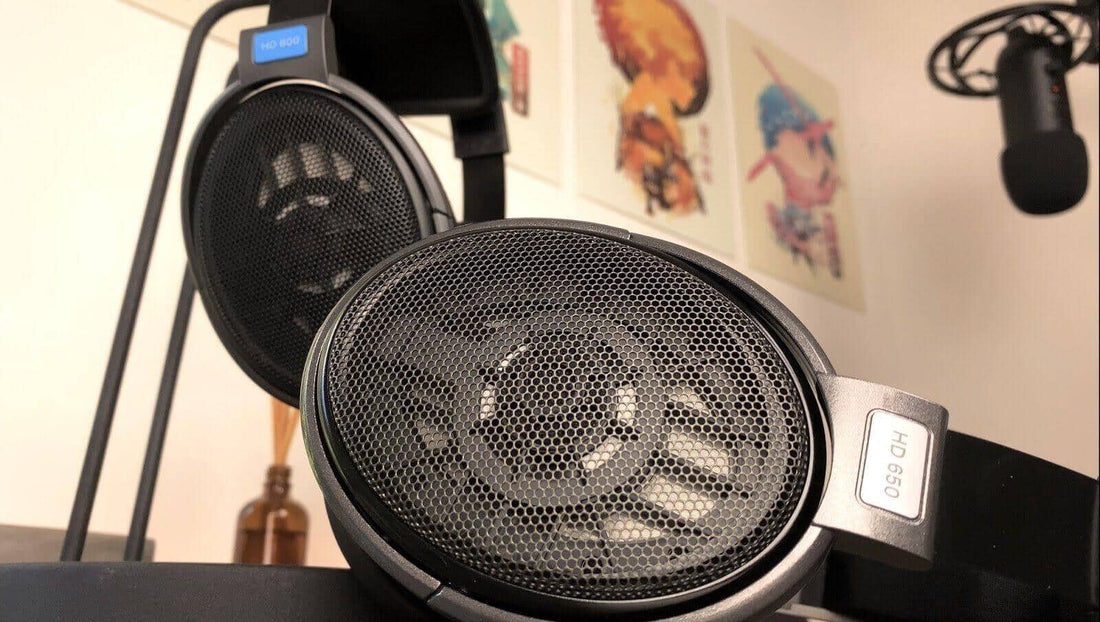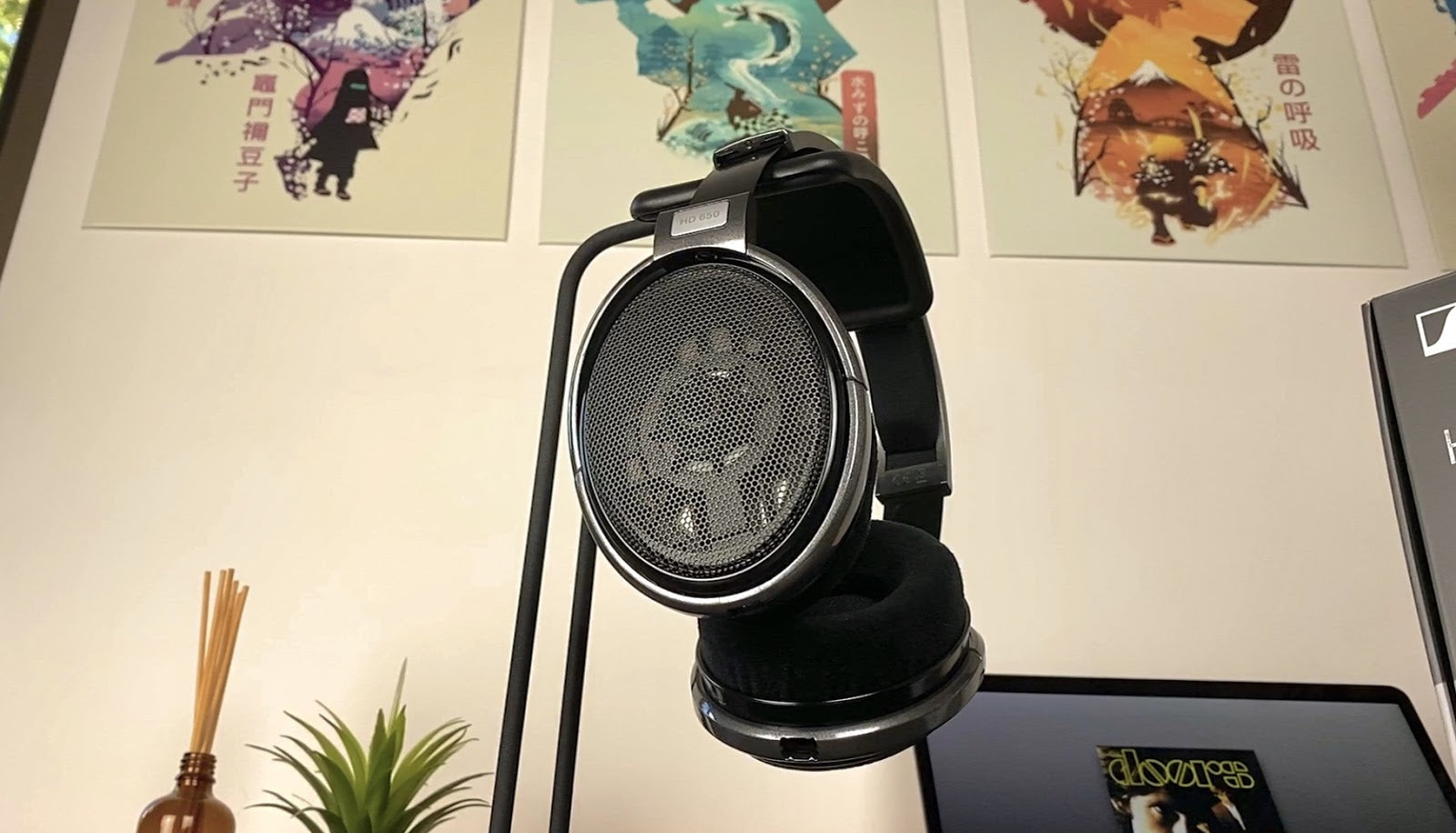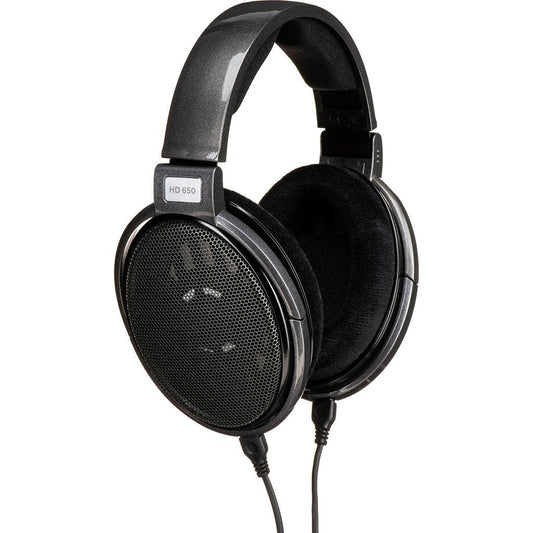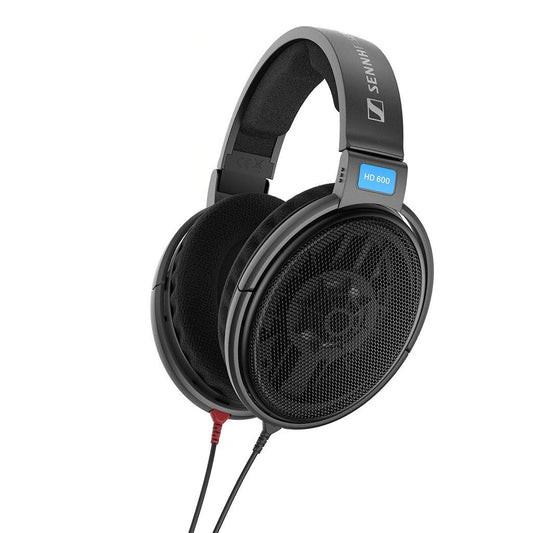Sennheiser HD 650 vs HD 600 Review - Revisiting Classics in 2020

Sennheiser’s HD 600-series is undoubtedly one of, if not the most, successful and beloved audiophile headphone line-up ever created. For many years after their release, the HD 600 ($399) and HD 650 ($499/$220) were considered by many to be the standard for reference-class headphones; enamoring listeners with a sound that is often described as highly musical, natural, and remarkably accurate. Now revisiting them in 2020 and considering the current headphone market, I want to find out: do the HD 600 and HD 650 still live up to their legendary status?
NOTE: The DROP X Sennheiser HD 6XX is essentially an HD 650 that’s using the older-style HD 600-series chassis and a midnight blue finish. Aside from those aesthetic changes the sonic characteristics of the HD 6XX and HD 650 should be identical.
Sennheiser HD 650 Headphones
Sennheiser HD 600 Headphones
Sources and Music Used in Listening Tests
The Amplifier/DACs used in this review were the SPL Phonitor XE (with built-in DAC), Grace Design SDAC + Topping A90, and the JDS Labs Element II connected via USB to my desktop computer. For the listening tests I used music from a wide variety of genres including Rock, Jazz, Classical, Acoustic, Hip-Hop, and latin. I played tracks from my own FLAC library as well as from Qobuz streaming service played via Roon (exclusive mode).
What’s in the Box?
Unfortunately, in the latest HD 600 and HD 650 revision, Sennheiser has ditched the rather nice, large case that used to package the HD 600 headphones; the packaging is now identical to that of the DROP X Sennheiser HD 58X Jubilee.Regardless, you still get the same accessories you would have with the previous revisions. Whilst, both headphones include a 3m cable that terminates in Sennheirser’s dual-sided proprietary connectors for the headphone side, theHD 600 terminates in 3.5mm with a thread-on ¼” adapter, and the HD 650 has a ¼” termination and a very short ¼” to 3.5mm cable. Additionally, I think that it is worth noting that the HD 600’s cable specifically is different from that included with the HD 650 and HD 660S. The HD 600 still includes a cable that is very similar to that which Sennheiser originally packaged with it back in the late nineties, and it feels somewhat frail and prone to tearing when compared to the more robust cable that is included with the HD 650 and HD 660S.
💡Also Consider: Shop the Sennheiser HD 660S at the best price on Headphones.com
Power Requirements
Both the HD 600 and HD 650 use a very similar 300 ohm driver, however the HD 600 is rated at 97db/mw, and the HD 650 is rated at 103db/mw. Without a doubt, you will need an amplifier to drive these and get them to sound right. With that being said, I do think that most amplifiers will suffice in cleanly driving these, as they sounded pretty good on entry-level sources like the JDS Labs Atom set to high-gain.

Now, I do not think it is possible to talk about the HD 600 and HD 650 without discussing their ability to scale with the source equipment used, and from my listening experience with them they definitely did scale when paired with higher-end amplifiers. When powered by, for example, the SPL Phonitor XE, the HD 600 and HD 650 saw a rather significant and sincerely impressive increase in midrange and treble resolution, getting fairly close to the level of detail and clarity that I would expect from something like an LCD-2.
Build Quality & Comfort
Minus some aesthetic changes in the latest revisions of the HD 600 and HD 650, the build on these headphones has remained virtually unchanged since their original introduction over twenty years ago, and with good reason. Despite being built almost entirely out of plastic, the HD 600-series’ design is one of the most reliable and durable out there. I have owned a couple of HD 600-series headphones over the years, and I have never run into any build quality issues–no cracks in the plastic, no loose parts, and no unbearable creaking. The only part of the build I can really flaw is the pads, which tend to wear out very quickly and will likely need to be replaced once or twice a year depending on your usage.

Out of the box, I feel like the HD 600-series headphones have a little too much clamp. However, after giving them a couple of days worth of wearing them, they ease up quite nicely. Thanks to the mostly-plastic construction, these headphones are extremely light at 260g; they never feel like they are weighing down on your head. The pads may look a little shallow, but I never really felt as though my ears came in contact with the driver, and they do actually provide a bit of room for your ears to fit in. After you give the clamp a bit of time to go away, I think that these become some of the most comfortable headphones you can buy, and I feel like I am able to wear these headphones practically all day without feeling fatigued or sore; I really doubt comfort will be an issue for anyone on these.

Sound
The HD 600 and HD 650 were designed to be “neutral,” reference-listening headphones–and I think most listeners would agree that Sennheiser succeeded in meeting that design goal.
For the most part, the HD 600 and HD 650 have a similar sonic signature; both possess an exceptionally natural-sounding tonal balance that is delivered in an intimate presentation with a great sense of speed. However, they have distinct traits that set them apart and could make you choose one over the other, or even encourage you to own both as contrasting flavors. In this sound section, I will be sharing how the HD 600 and HD 650 compared to each other in my listening experience and how they stack up against more modern headphones.
Bass
The bass is one of the regions where the HD 600 and HD 650 differ a fair bit and sets them apart from each other. They do have some similar characteristics in the bass, but listening to them side-by-side it is very clear that the HD 650 has significantly more presence in the lows, whilst the HD 600 delivers a flatter bass response. Both the HD 600 and HD 650 see a bump in the mid-bass at around 150hz, and while I do not think that it is that noticeable on the HD 600, it is a prominent quality of the HD 650’s tonal character. The bigger emphasis on the HD 650’s midbass lends its bass response a considerable but tasteful amount of warmth that adds an enjoyable fullness to it without ever feeling overbearing or intrusive of other frequency ranges.
Now whilst I do like both the HD 600 and HD 650’s bass tunings, I do have to admit that, to me, they do seem to lack the precision and technicalities that more modern headphones have to offer in this region of frequency response. The bass on the HD 600 and HD 650 never sounds undefined or lacking in structure, but it definitely does not strike as being presented with the same level of control and articulation that headphones like the Beyerdynamic DT 1990 Pro and HiFiMan Sundara can achieve. Furthermore, the bass on the HD 600 and HD 650 is missing quite a bit of depth in the sub-bass region; to me they sound as though they roll-off quite steeply under 80hz, especially on the HD 600.

Mids
The midrange is what the HD 600 series is mainly known for, and it is the definitely the star of the show. The HD 600 and HD 650 both feature a nearly-identical midrange presentation; and for my tastes and preferences, I can only describe their mids as ridiculously realistic in their tonality and extremely natural in their timbre. I find that both of these headphones really do have a beautiful voicing in the midrange that delivers extremely organic vocal and instrument tones.
There is, however, one very slight difference present in the mids between the HD 600 and the HD 650, as the HD 650 does seem to have a little added energy at around 300hz. This added emphasis at 300hz gives the HD 650’s lower mids a subtle, but present boost that enhances their tonal richness and empowers vocals and low instrument tones. If there is one complaint I have with the HD 600 and HD 650’s mids is that, to me, they sound just a little bit too forward in the upper midrange for me, particularly at around 3.5K.
This elevation in the presence region can make electric guitars and brass instruments in particular come across as shouty and occasionally harsh. Aside from that, the midrange tonality on these really is spectacular, and I still think that it is one of the best midrange tunings I have heard from any headphone. Resolution is also great in the midrange, as I personally think that the HD 600 and HD 650 both possess some of the most transparent and resolving mids of any headphone in the sub-$600 price range, and in this regard they only get better when paired with higher-end gear.
Highs
The treble region is where–again–the HD 600 and HD 650 differ a little bit more significantly for frequency response. Starting with the HD 600, I find it to have an adequate amount of energy and sparkle in the highs; I personally did not find it to be veiled in any way. Additionally, the HD 600 has fantastic treble extension, with good air qualities above 10K that add a nice texture and glisten to the highs while also enhancing the overall perceived resolution from the headphone.
For the most part I found the treble on the HD 600 to be very inoffensive, although to me it did sound like it could be a little peaky at two different spots. For me, 6K could come across as just a little forward and introduce the slightest bit of sibilance in the low treble. I also found that to my taste, 10K has just a little too much energy; cymbal crashes and drum strikes had a little more zing than I would personally prefer. On the other hand we have the HD 650, which has a treble region that I would describe as being very warm, and very smooth.
The overall treble level between 6K-10K sounds to me like is set 1dB-2dB lower than that of the HD 600, so it is quite a bit darker, and I can see how it could earn it the title of veiled. However, I still think that the HD 650 has a fantastic tuning that whilst being very smooth and relaxed, does remain capable of conveying all the tonal nuances in the highs.For resolution, I think that the HD 600 and HD 650 are both very resolving in the treble region, sounding cleaner and more transparent in their delivery than the HiFiMan Sundara and DT 1990 Pro. Also very important to mention is that–like the midrange–the HD 600 and HD 650’s detail retrieval capabilities in the treble range scaled with the source used, and they again reached higher levels of performance when powered by the Phonitor XE.

Soundstage, Imaging, and Layering
The soundscape created by the HD 600 and HD 650 is a very intimate one, with a very forward center stage and fairly closed-in lateral images. While I do not think it has a claustrophobic presentation, this lack of width is, for me, one of the drawbacks of the HD 600 series, and it is a category where many of the other headphones in their price range such as the DT 1990 Pro and Sundara perform better. Imaging and sense of directionality are, unfortunately, also a little lackluster as the HD 600 and HD 650 since both seem to have a slight gap at front-left and front-right; resulting in a soundstage that is focused mainly on the center, left, and right images. Instrument separation and layering, however, I think is fairly impressive on the HD 600 and HD 650 when you consider the small soundstage that they are working with.
Even during complex musical passages, I never feel like vocals or instruments get lost or drowned out–they maintain a well-defined space of their own within the stage. In this regard I think the HD 600 and HD 650 actually perform better than the DT 1990 Pro, and are about on par with the Sundara. Lastly, I would also like to mention that, to me, the HD 600 sounded ever-so-slightly more “open” than the HD 650, which is likely due to the HD 600 not having the additional bass presence filling up the space like it does on the HD 650, or the 300hz boost that elevated the sense of intimacy from lower midtones.
Dynamics
Dynamics is a category where I think that the HD 600 series headphones perform decently well. Whilst they do not have the strongest sense of punch and slam, they still provided a decent kick behind bass notes, and when listening to acoustic guitars, strings were reproduced with a nice top-end attack that gave them a decent feeling of tension and presence. Overall, I found the dynamics to still possess a good impact and strike that made them fairly engaging to listen to.
EQ
Both the HD 600 and HD 650 are extremely natural-sounding headphones that I really do not think need EQ at all, but I have made profiles for them that bring them just a little bit closer to my personal preference, and to be more specific, target the upper midrange which was a little too forward for me. If you would like to try out my preset for the HD 600 and/or the HD 650, these are the settings that I used:
HD 600
- Low Shelf at 85hz, +3dB Q of 0.7
- Peak at 3500hz, -3dB Q of 2
- Peak at 6000hz, -2dB Q of 4
- Peak at 10000hz, -3dB Q of 3
HD 650
- Low Shelf at 85hz, +3dB Q of 0.7
- Peak at 200hz, -3dB Q of 1.2
- Peak at 3000hz, -2dB Q of 2
Love our in-depth reviews? Sign up for our newsletter to get notified about more in-depth reviews, upcoming products, and deals for Headphones.com
Sennheiser HD 600 Headphones
Sennheiser HD 650 Headphones
Conclusion
I am sincerely impressed every time I get the opportunity to re-listen to these two headphones. With their incredibly natural tonality, good technical performance, great comfort and build, HD 600 and HD 650 have, without a doubt, stood the test of time and still remain one of the best options under $500, it is then just a matter of choosing the flavor that is more to your liking: Do you prefer a slightly warmer headphone with a sense of fullness in the bass, strong, tonally-rich vocals and a smooth, relaxed treble range? Go with the HD 650. Looking for a headphone of which tonality feels remarkably true-to-source, has present mids, and highly-articulated highs? Then the HD 600 is the Sennheiser headphone for you. If you want to get a taste of what many listeners, including myself, consider to be the reference sound, then I do not think you can go wrong with either of these two headphones—they offer a fantastic listening experience at a great price.
Watch the video review:
Written by @Chrono
---
Discuss the Sennheiser HD650 and HD600 on the HEADPHONE Community Forum.

